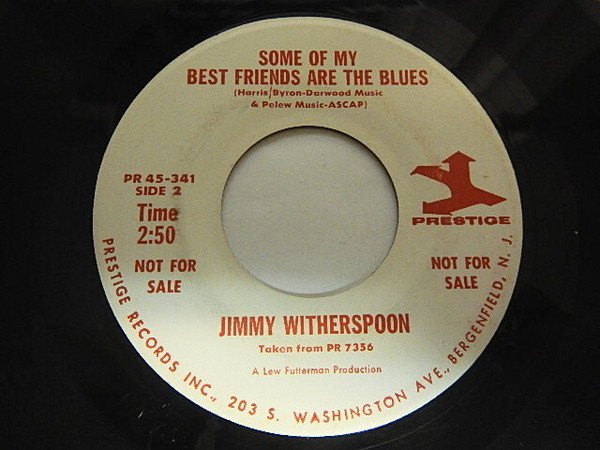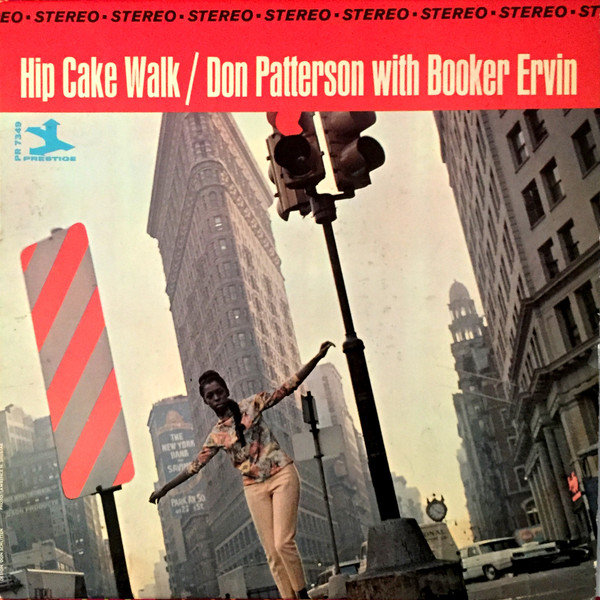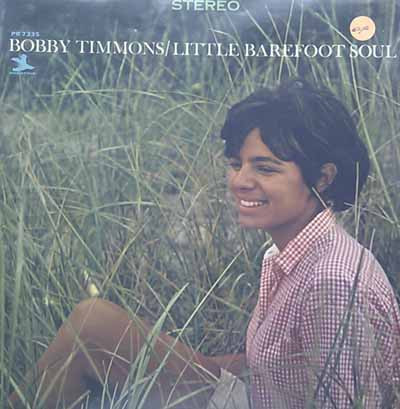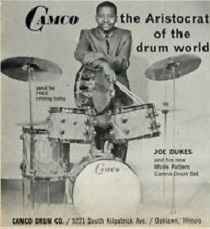LISTEN TO ONE: Every Time I Think About You
Ambitious and serious-minded Stockholm Sojourn may have been, but after he'd finished one day of it (he was to bring his International Jazz Orchestra back into the studio in August), Benny Golson wasn't above having a little fun with many of the same musicians and a visiting blues singer. July 14, a Tuesday. was Stockholm Sojourn day, and for the rest of the week he sojourned with Jimmy Witherspoon, some orchestral sounds, and eclectic selection of tunes.
Witherspoon was no stranger to eclecticism. An Arkansas native, he first achieved recognition in Calcutta, India, singing over Armed Forces Radio.
A return to the States gave him his first recording dates with the straight-ahead Kansas City swing of Jay McShann, but he would soon become known for for his mastery of a range of styles and material.
That range is on display here, and it also raises questions. Golson and Witherspoon hadn't worked together before, as far as I can tell, and certainly neither of them had worked with the Swedish musicians beyond the rehearsals for Stockholm Sojourn. So where did the songs for these sessions come from? You can't just tell a group of 15 people who are essentially strangers to you, "I'll just hum a few bars and you can fake it."
One theory, and it's probably as good as any: they decided to record whatever songs they were able to find the sheet music for by scrounging around Stockholm.
Here's what they came up with, and I'm spending more time than I ought to on this set list because of a fascination of the sort usually reserved for train wrecks--except that crawling from the wreckage comes a mostly very good album, thanks to the talents of Messrs. Golson and Witherspoon.
"Some of My Best Friends Are the Blues," with 'Spoon in his best seductive crooning mode, but never letting you forget he can belt out a blues with the best of them, and make it sound authentic even with the accompaniment of a brass and woodwind orchestra. And even with a somewhat manufactured song, written by Al Byron and Woody Harris. Byron is probably best known for writing one of the sappiest love songs ever recorded, Bobby Vinton's "Roses are Red." He also had one cut with Elvis, "Something Blue," a song very much in the vein of "Roses are Red." His partner Woody Harris worked extensively with Bobby Darin, in a peppier, more uptempo vein than Byron--their biggest success was "Queen of the Hop." Harris also had an Elvis cut, a song called "I Want You With Me,"first recorded by Darin. He was responsible for one of the worst examples of Tin Pan Alley's early, gingerly flirtation with rock 'n roll. "Rock-a-Billy," a sort of hit for Forties crooner Guy Mitchell, the sort of singer that the gingerly Tin Pan Alley tunesmiths were comfortable with. He also wrote a song called "Dix-a-Billy," which was probably even worse than "Rock-a-Billy," but it sounds a little better, because it was sung by LaVern Baker. And "Brand New House," originally written for Darin, became a solid blues in the hands of Otis Spann.the sort of singer that the gingerly Tin Pan Alley tunesmiths were comfortable with. He also wrote a song called "Dix-a-Billy," which was probably even worse than "Rock-a-Billy," but it sounds a little better,because it was sung by LaVern Baker. And "Brand New House," originally written for Darin, became a solid blues in the hands of Otis Spann.the sort of singer that the gingerly Tin Pan Alley tunesmiths were comfortable with. He also wrote a song called "Dix-a-Billy," which was probably even worse than "Rock-a-Billy," but it sounds a little better, because it was sung by LaVern Baker. And "Brand New House," originally written for Darin, became a solid blues in the hands of Otis Spann.but it sounds a little better, because it was sung by LaVern Baker. And "Brand New House," originally written for Darin, became a solid blues in the hands of Otis Spann.but it sounds a little better, because it was sung by LaVern Baker. And "Brand New House," originally written for Darin, became a solid blues in the hands of Otis Spann.
In spite of that, there's not much to suggest that either of these two guys would be capable of writing a real blues, much less collaborate on one. But this song waas recorded by Della Reese and Lena Horne -- both of them night club singers, but with real resources of soul--before Golson/Witherspoon.
Surely, though, this couldn't have been floating around Stockholm in sheet music form? Perhaps 'Spoon brought it with him, hoping he'd run into Golson or someone like him, or else just wanting to sing the song in some European clubs, and figuring he'd need the music for whoever he picked up to play with him.
"Every Time I Think About You" was written by Claude Demetrius--I guessed, from the name, a European, possibly even a Swede.
I guessed wrong. Claude Demetrius was that anomaly of anomalies, an African-American from Bath, Maine, whe escaped to New York at the age of 20, where he must have felt he'd found his real home, and he began writing for, and with, Louis Armstrong. In the '40s he wrote with, and for, Louis Jordan, including the hit "Ain't That Just Like a Woman." For bookkeeping reasons, or tax reasons, Jordan assigned writing credit for this and a number of his other songs to his then wife, Fleecie Moore. When they got divorced, Fleecie lived up to her name, and Jordan never did get the credit or royalties for those songs, and "Just Like a Woman" was widely covered, including by both Fats Domino and Chuck Berry. So Demetrius did well for himself until the mid-1950s. when he started doing very well indeed. His "I Was the One" was the flip side of Elvis Presley's mega-hit "Heartbreak Hotel," and it was just the beginning of his career writing for Elvis, a career that included "Mean Woman Blues" (also covered by Jerry Lee Lewis), and a mega-hit of his own, "Hard Headed Woman."
"Every Time I Think About You" is a terrific vehicle for 'Spoon, and one of Golson's best arrangements. It may well have been another tune that 'Spoon brought with him.
"I Never Will Marry" seems a little less likely to have been in his steamer trunk. A gentle folk song, probably of traditional origin but credited to A. P. Carter and first recorded by the Carter Family, it was a staple of hootenannies and campfires, and probably best known for its rendition by the Weavers--or maybe the sly sendup by the Smothers Brothers. Golson gives him a vocal chorus (uncredited) and strings (also uncredited). Golson is having some fun here, but Witherspoon plays it straight, gives the song a sensitive, folkie treatment.
"I Wanna Be Around" was a new song, a hit for Tony Bennett and destined to become a jazz standard, with a weird story all its own. Sadie Vimmerstedt, a grandmother from Youngstown, Ohio, was inspired by the movie magazine stories of the doomed romance of Frank Sinatra and Ava Gardner, to write a song. Well, not a whole song. Sadie wasn't exactly a songwriter, but she did come up with a first line: "I want to be around to pick up the pieces, when somebody breaks your heart." That was all she had, but she was a huge Johnny Mercer fan, so she put it in an envelope and addressed it to "Johnny Mercer, New York, NY." Somehow it got to Mercer, and it tickled his fancy enough that he wrote a song around it. And here's where the story really gets good--in an industry noted for unscrupulousness and thievery,Mercer gave full co-writing credit, and one third -- some say half -- of the royalties to Sadie. Mercer turned Sadie's one line into one of the great popular songs. Bennett did right by the song's two composers, both in 1962 and half a century later, in a duet with British rocker Bono. By that time, virtually every singer of note had recorded it. By 1964, it had already been covered by Julie London, Aretha Franklin, Dinah Washington, Frank Sinatra with Count Basie, and a host of others. Still, Witherspoon and Golson were among the early admirers, and surely the sheet music would have reached Sweden. 'Spoon can croon with the best of them, and he as he assimilates some of Tony Bennett in his rendition, he never lets you forget he's a blues singer. Golson captures a Basie feeling in his arrangement,and one third -- some say half -- of the royalties to Sadie. Mercer turned Sadie's one line into one of the great popular songs. Bennett did right by the song's two composers, both in 1962 and half a century later, in a duet with British rocker Bono. By that time, virtually every singer of note had recorded it. By 1964, it had already been covered by Julie London, Aretha Franklin, Dinah Washington, Frank Sinatra with Count Basie, and a host of others. Still, Witherspoon and Golson were among the early admirers, and surely the sheet music would have reached Sweden. 'Spoon can croon with the best of them, and he as he assimilates some of Tony Bennett in his rendition, he never lets you forget he's a blues singer. Golson captures a Basie feeling in his arrangement,and one third -- some say half -- of the royalties to Sadie.Mercer turned Sadie's one line into one of the great popular songs. Bennett did right by the song's two composers, both in 1962 and half a century later, in a duet with British rocker Bono. By that time, virtually every singer of note had recorded it. By 1964, it had already been covered by Julie London, Aretha Franklin, Dinah Washington, Frank Sinatra with Count Basie, and a host of others. Still, Witherspoon and Golson were among the early admirers, and surely the sheet music would have reached Sweden. 'Spoon can croon with the best of them, and he as he assimilates some of Tony Bennett in his rendition, he never lets you forget he's a blues singer. Golson captures a Basie feeling in his arrangement,Mercer turned Sadie's one line into one of the great popular songs. Bennett did right by the song's two composers,both in 1962 and half a century later, in a duet with British rocker Bono. By that time, virtually every singer of note had recorded it. By 1964, it had already been covered by Julie London, Aretha Franklin, Dinah Washington, Frank Sinatra with Count Basie, and a host of others. Still, Witherspoon and Golson were among the early admirers, and surely the sheet music would have reached Sweden. 'Spoon can croon with the best of them, and he as he assimilates some of Tony Bennett in his rendition, he never lets you forget he's a blues singer. Golson captures a Basie feeling in his arrangement,Mercer turned Sadie's one line into one of the great popular songs. Bennett did right by the song's two composers, both in 1962 and half a century later, in a duet with British rocker Bono. By that time,virtually every singer of note had recorded it. By 1964, it had already been covered by Julie London, Aretha Franklin, Dinah Washington, Frank Sinatra with Count Basie, and a host of others. Still, Witherspoon and Golson were among the early admirers, and surely the sheet music would have reached Sweden. 'Spoon can croon with the best of them, and he as he assimilates some of Tony Bennett in his rendition, he never lets you forget he's a blues singer. Golson captures a Basie feeling in his arrangement,both in 1962 and half a century later, in a duet with British rocker Bono. By that time, virtually every singer of note had recorded it. By 1964, it had already been covered by Julie London, Aretha Franklin, Dinah Washington, Frank Sinatra with Count Basie, and a host of others. Still, Witherspoon and Golson were among the early admirers,and surely the sheet music would have reached Sweden. 'Spoon can croon with the best of them, and he as he assimilates some of Tony Bennett in his rendition, he never lets you forget he's a blues singer. Golson captures a Basie feeling in his arrangement,both in 1962 and half a century later, in a duet with British rocker Bono. By that time, virtually every singer of note had recorded it. By 1964, it had already been covered by Julie London, Aretha Franklin, Dinah Washington, Frank Sinatra with Count Basie, and a host of others. Still, Witherspoon and Golson were among the early admirers, and surely the sheet music would have reached Sweden. 'Spoon can croon with the best of them, and he as he assimilates some of Tony Bennett in his rendition, he never lets you forget he's a blues singer.Golson captures a Basie feeling in his arrangement,Still, Witherspoon and Golson were among the early admirers, and surely the sheet music would have reached Sweden. 'Spoon can croon with the best of them, and he as he assimilates some of Tony Bennett in his rendition, he never lets you forget he's a blues singer. Golson captures a Basie feeling in his arrangement,Still, Witherspoon and Golson were among the early admirers, and surely the sheet music would have reached Sweden. 'Spoon can croon with the best of them, and he as he assimilates some of Tony Bennett in his rendition, he never lets you forget he's a blues singer. Golson captures a Basie feeling in his arrangement,Spoon can croon with the best of them, and he as he assimilates some of Tony Bennett in his rendition, he never lets you forget he's a blues singer. Golson captures a Basie feeling in his arrangement,Still, Witherspoon and Golson were among the early admirers, and surely the sheet music would have reached Sweden. 'Spoon can croon with the best of them, and he as he assimilates some of Tony Bennett in his rendition, he never lets you forget he's a blues singer. Golson captures a Basie feeling in his arrangement,Spoon can croon with the best of them, and he as he assimilates some of Tony Bennett in his rendition, he never lets you forget he's a blues singer. Golson captures a Basie feeling in his arrangement,Still, Witherspoon and Golson were among the early admirers, and surely the sheet music would have reached Sweden. 'Spoon can croon with the best of them, and he as he assimilates some of Tony Bennett in his rendition, he never lets you forget he's a blues singer. Golson captures a Basie feeling in his arrangement,and he as he assimilates some of Tony Bennett in his rendition, he never lets you forget he's a blues singer. Golson captures a Basie feeling in his arrangement,and he as he assimilates some of Tony Bennett in his rendition, he never lets you forget he's a blues singer. Golson captures a Basie feeling in his arrangement,
"Teardrops From My Eyes" was written by the great rhythm and blues songwriter Rudy Toombs, and was one of Ruth Brown's first hit records for Atlantic. Its early recording history is a tribute to the bizarre catholicism of the 1950s. Cover versions include solid R&B (Wynonie Harris with Lucky Millinder), schmaltzy pop (Fran Warren with Hugo Winterhalter), a pop-country hybrid (Jo Stafford with Gene Autry), deep country (Hawkshaw Hawkins), and jazz (Ella Fitzgerald). Everyone likes a good song. 'Spoon and Golson liked it too, and it shows.
"And the Angels Sing" is Mercer again, with a somewhat more expected collaborator, swing trumpeter and Benny Goodman sideman Ziggy Elman. Originally introduced by Goodman, who swung it, it became more of a heavily orchestrated ballad in later versions, and Golson gives it all of that, bring back the backup vocalists for an angelic choir.
This one has to have come from whatever sheet music they may have been able to scrounge up in Stockholm. "Who's Sorry Now?" was written in 1923 by composer Ted Snyder and the songwriting team of Bert Kalmar and Harry Ruby, and became, over the years, a mildly popular if undistinguished number. People kept recording it. It was waxed two dozen times from the '20s through the '40s, almost entirely by performers who are forgotten today (Glenn Miller, Harry James and Bing Crosby all made it the flip side of 78 RPM releases). Then in 1958 it finally got its moment in the sun, as Connie Francis, a struggling young singer who had released several flops and was about to give it up and go to med school, recorded the song at the urging of her father. Francis hated the song and was looking for more contemporary material,but her father kept nagging her, and finally she stuck it in at the end of a recording session. Dick Clark played it on American Bandstand, it got a positive response, he booked Francis for the premiere telecast of his new prime variety show, and suddenly Connie Francis was the hottest thing around, and the song was a million seller, and a nice piece of change in the retirement accounts of Snyder and Ruby (Kalmar was deceased by then). But it still wasn't a very good song. Witherspoon does what one is tempted to do with mediocre material -- pushes it too hard, over-enunciates every word, over-dramatizes it. It's not the musical highlight of this session.he booked Francis for the premiere telecast of his new prime variety show, and suddenly Connie Francis was the hottest thing around, and the song was a million seller, and a nice piece of change in the retirement accounts of Snyder and Ruby (Kalmar was deceased by then). But it still wasn't a very good song. Witherspoon does what one is tempted to do with mediocre material -- pushes it too hard, over-enunciates every word, over-dramatizes it. It's not the musical highlight of this session.he booked Francis for the premiere telecast of his new prime variety show, and suddenly Connie Francis was the hottest thing around, and the song was a million seller, and a nice piece of change in the retirement accounts of Snyder and Ruby (Kalmar was deceased by then). But it still wasn't a very good song. Witherspoon does what one is tempted to do with mediocre material -- pushes it too hard, over-enunciates every word, over-dramatizes it. It's not the musical highlight of this session.Witherspoon does what one is tempted to do with mediocre material -- pushes it too hard, over-enunciates every word, over-dramatizes it. It's not the musical highlight of this session.Witherspoon does what one is tempted to do with mediocre material -- pushes it too hard, over-enunciates every word, over-dramatizes it. It's not the musical highlight of this session.
"You're Next" is a pop song by Sid Tepper, who had a successful career in 1940s and '50s, and an even more successful career in '60s, although not exactly on the cutting edge of that decade's burgeoning musical creativity. He and his partner, Roy C. Bennett, wrote 43 songs that were sung by Elvis in his various movies. "You're Next" could well have been one of them, although it doesn't seem to have quite made the cut. Its sheet music may well have floated over to Stockholm, though. Don't forget this recording session with Benny Golson, and a bunch of Swedes who wouldn't have had all that many chances to play with an American jazz legend like Golson, lasted for almost a week, and by this time they must have been really scrounging for material. But it's fun -- more fun than "Who's Sorry Now?" -- and Witherspoon gives a little of that Elvis intonation.
"Happy Blues" has a piano, probably played by Witherspoon, since there's no piano listed in the session's credits. This has to be from 'Spoon's regular set list. He plays and sings it with gusto. Golson brings the choir back, and they complement him nicely.
"That's Why I'm Leaving" was written by Lockie Edwards Jr., who receives what may be my all-time favorite billing, on a CD of songs written by him and collaborator Larry Weiss -- "Forgotten Legendary Songwriters." The CD, a collection of 32 songs, is entitled "Unforgotten Yesterdays," but it doesn't live up to its title. Weiss and Edwards are more forgotten than legendary. They do have one more unforgettable credit -- among the genres this CD associates them with is "Belgian popcorn." "That's Why I'm Leaving" is not one of the 32 forgotten unforgottens, and it might have been forgotten had not Golson and Witherspoon needed to find one more song to fill out the record, but it's really not abad song at all.
Neither is Witherspoon's own "One Last Chance," which caps the session.
And I've had some fun with the song selection, but this is a very good record, an unusual, unlikely, and very satisfying collaboration between two actually unforgotten jazz legends, and I'm glad I listened to it.
The album was called Some of My Best Friends Are the Blues, released on Prestige (Bluesville was now defunct). Prestige also released three 45 RPM singles, "You're Next" / "Some Of My Best Friends Are The Blues," "Happy Blues" / "I Never Will Marry," and "Oh How I Love You" (not from the session) / "One Last Chance."
























.jpg)


